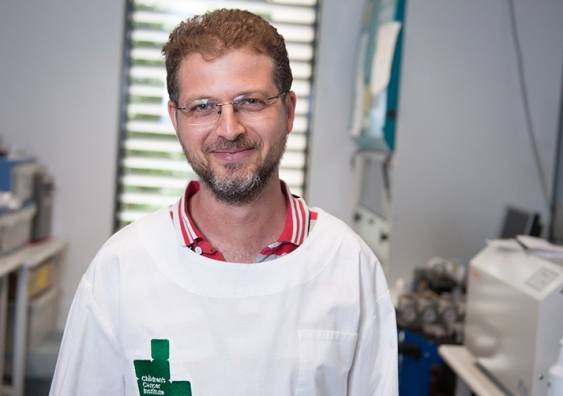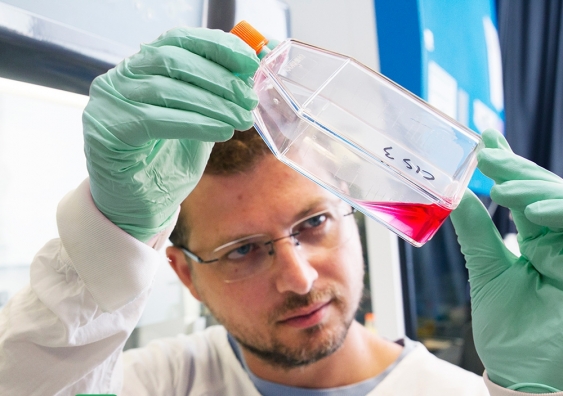A drug used to manage copper levels could improve the odds for children battling neuroblastoma, new research in animal models suggests.
The survival rate for children with a rare but deadly cancer could one day be improved by adding an existing drug ÔÇô which is currently used to manage excess copper in the body ÔÇô to their treatment.
The drug can be used to weaken tumours and strengthen the fighting capacity of immune cells, increasing the success rate of a cancer treatment for high-risk neuroblastoma from 10% to 50%, new research in mice led by ╣·├±▓╩ã▒ Sydney shows.┬á
The findings, published in on Thursday night, offer hope for those with neuroblastoma, which accounts for 15% of childhood cancer deaths. 
Neuroblastoma is a cancer that develops from immature nerve cells, known as neuroblasts, found in several areas of the body, most commonly around the adrenal glands. It is most common in infants and children under five years of age.
Despite aggressive treatments, children diagnosed with high-risk neuroblastoma have a one-in-two chance of surviving the disease. This drops to one-in-10 for children who relapse.
For those children, their last chance was anti-GD2 antibody therapy, said lead researcher and senior report author Associate Professor Orazio Vittorio, from ╣·├±▓╩ã▒ÔÇÖs School of Biomedical Sciences and the .
ÔÇ£It is one of the most important therapies developed, but it only works if there is a strong immune system,ÔÇØ A/Prof. Vittorio said.┬á
ThatÔÇÖs where the drug TETA (triethylenetetramine), marketed as Cuprior, comes in.
Media enquiries
For enquiries about this story and interview requests, please contact┬áKate Burke, News & Content Coordinator, ╣·├±▓╩ã▒ Medicine & Health.
Tel: +61 2 9348 2538
Àí│¥▓╣¥▒▒¶:╠²kate.burke@unsw.edu.au
'Like Robin HoodÔÇÖ: Helping the immune system fight back
TETA is copper chelating agent which is currently used to treat WilsonÔÇÖs disease ÔÇô a genetic disorder resulting in excess copper build up. The drug binds to and removes the metal from the body.┬á
Researchers previously discovered they could use TETA to weaken neuroblastoma tumours, by removing the copper which they ÔÇÿfeedÔÇÖ on. Now they have shown in mice that they can transfer this copper to neutrophils, a type of white blood cell that helps the body fight infection and heal injuries.
ÔÇ£It has the double effect of weakening the tumour and empowering the immune system to be strong and fight back,ÔÇØ said A/Prof. Vittorio.┬á
ÔÇ£When we combine it with the immunotherapy currently used for neuroblastoma, we can increase the survival rate for high risk cases from 10% to 50%.ÔÇØ
A/Prof. Vittorio compares the drugÔÇÖs effect to the legend of Robin Hood.
ÔÇ£The tumour is like this greedy rich guy who basically takes the money, or in this case copper, from the immune cells, making them very weak. Then the drug, our Robin Hood, comes in, steals the copper and gives it back to the immune cells, so they can become stronger and fight back.
ÔÇ£It re-establishes that equilibrium that was compromised by the presence of the tumour,ÔÇØ he added.
A/Prof. Vittorio stressed that increasing copper intake via dietary changes or supplements would not have the same effect. 
ÔÇ£Never ever increase the level of copper you are taking if you have a tumour, because without this drug, all the extra copper available will reach the tumour and make it stronger.ÔÇØ
The researchers, from a dozen institutions including ChildrenÔÇÖs Cancers Institute, The University of Western Australia, Curtin University and the Sydney ChildrenÔÇÖs Hospital Network, plan to start a multi-year clinical trial next year.┬á
More research key to evolving cancer treatment
Lead study author Dr Jourdin Rouaen, from ╣·├±▓╩ã▒ÔÇÖs School of Clinical Medicine and the ChildrenÔÇÖs Cancer Institute, hopes the combined therapy could one day improve the survival rate and quality of life for children with neuroblastoma.┬á┬á
"Copper chelation therapy represents a significant evolution from traditional cancer treatments. ItÔÇÖs non-toxic, has demonstrated no concerning side effects, and is already approved for use,ÔÇØ Dr Rouaen said.
The therapy also has the potential to work for other tumours, with the team working with Australian and US experts to study the impact of copper chelation on mesothelioma, caused by exposure to asbestos. They are also collaborating with US researchers to support a clinical trial testing the therapy for breast cancer patients. 
Dr Rouaen said the findings to date shone a light on the important role that could be played by often overlooked neutrophils.
ÔÇ£They are drastically understudied. We're challenging the paradigm of how useful these neutrophils can be, and we want to see more research into how these can be harnessed for immunotherapies in the future.ÔÇØ┬á
The benefit of repurposing existing drugs
It is hoped that the drug, if found effective in clinical trials, could become a routine part of immunotherapy treatment for neuroblastoma in the next few years.  
ÔÇ£It typically takes between eight to 13 years of research to develop a new drug for cancer treatment and costs an average of $US4.7 billion,ÔÇØ said Dr Rouaen.┬á
ÔÇ£By repurposing an existing drug weÔÇÖre saving a great deal of money and time, which is particularly crucial when weÔÇÖre looking to improve treatment for this deadly childhood cancer.ÔÇØ┬á┬á
ItÔÇÖs news that will offer hope to those affected by neuroblastoma, even if the treatment could still be some years away.┬á
The multi-year study was funded by a Cure Cancer Australia grant and National Health and Medical Research Council Ideas Grant. 
ÔÇ£We are proud to have supported this pioneering research from its earliest stages,ÔÇØ said Cure Cancer Australia Chief Executive Officer Nikki Kinloch.
ÔÇ£This breakthrough demonstrates the incredible potential of supporting emerging scientists who bring fresh perspectives and innovative approaches to cancer research."
Related stories
-

$5m boost in fight against childhood cancer
-

'Science saved my life': one doctor's incredible journey from cancer researcher to cancer survivor
-

ÔÇÿVery exciting resultsÔÇÖ: precision medicine for childhood cancer improves survival, trial shows
-

Blocking copper uptake in tumour cells may help boost immune system and fight the deadliest of cancers




